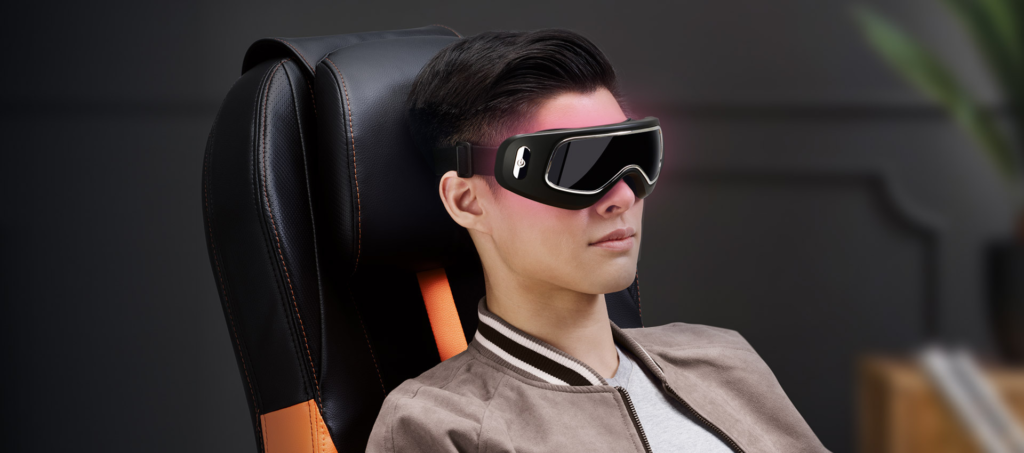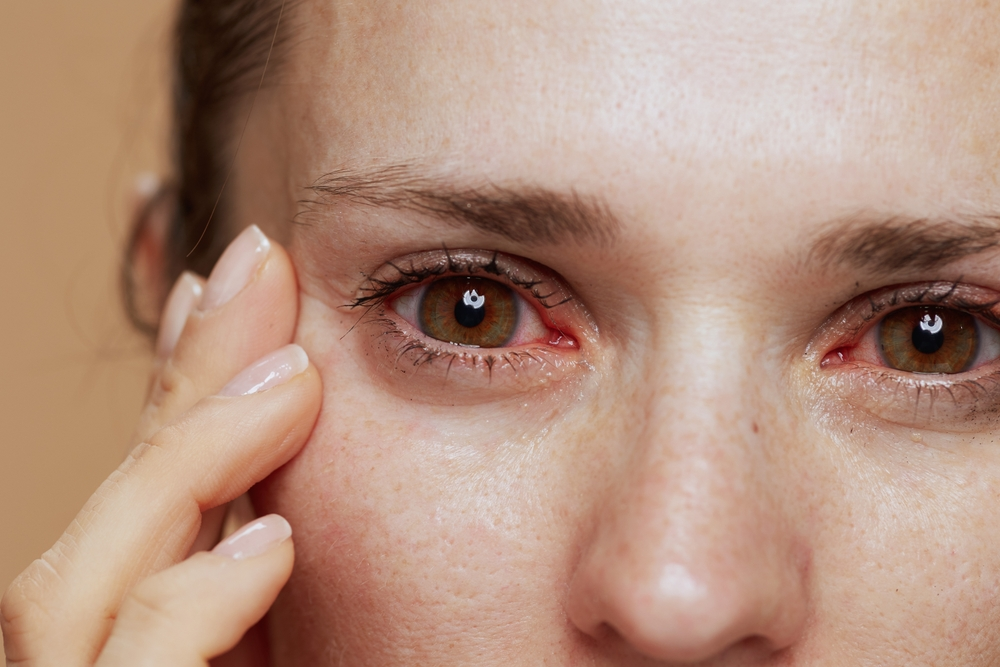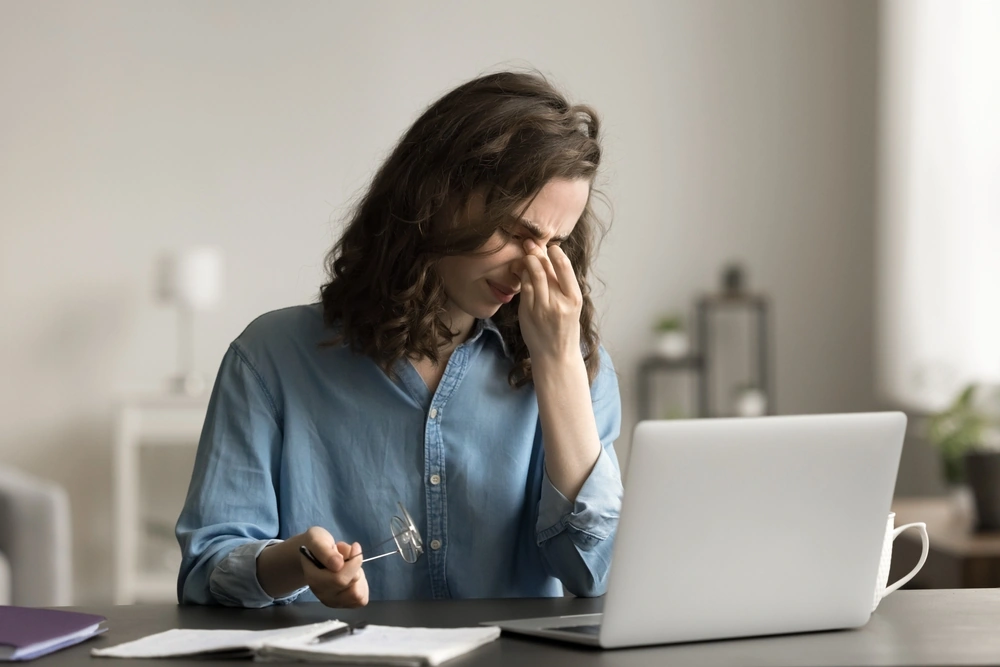Aching eyes aren’t just a mild annoyance — they can signal that your daily habits are pushing your vision too far. Hours spent focusing on screens, poor lighting, dry air, or even the wrong glasses can slowly build tension until the eyes aching becomes impossible to ignore.
This guide breaks down the real reasons your eyes are aching, how to tell if something more serious is going on, and what you can do to ease the strain. From simple at-home changes to knowing when to get medical advice, every step matters when it comes to protecting your eyes and restoring comfort.
Understanding Eye Pain: Where and Why It Happens
Eyes aching can take different forms — a dull ache behind the eyes, sharp pain during movement, or a heavy, tired sensation that makes it hard to concentrate. Identifying the type and source of pain helps determine the right solution.
Types of Eye Pain
- Ocular pain: Felt on the eye surface, often due to:
- Dryness
- Irritants like dust or wind
- Contact lens use
- Orbital pain: Deeper discomfort behind the eye, typically caused by:
- Sinus congestion
- Fatigued eye muscles
- Nerve-related conditions
Key Symptoms to Look For
- Eye discomfort when blinking – linked to surface dryness or eyelid irritation
- Eyeball pain when blinking – may signal strain, inflammation, or fatigue
- Feeling of pressure in one eye – often tied to sinus pressure or uneven muscle use
Understanding these signs can help you take early action before discomfort worsens.
What Causes Eyes Aching? Triggers and Medical Links
Pain or pressure behind the eyes may be related to everyday behaviours or underlying health issues. Recognising the cause allows you to choose the right path — whether it’s rest, home care, or professional treatment.
Common Everyday Triggers
- Prolonged screen use – reduces blink rate and dries the eye surface
- Strained eyes glasses – wearing incorrect prescriptions increases visual strain
- Dry indoor air – heating or air conditioning lowers humidity
- Poor lighting and posture – places excess stress on the visual system
- Lack of sleep – disrupts the eyes’ natural healing and lubrication
- Nutrient deficiencies – may compromise eye health and tissue repair
These factors often lead to eyes aching, particularly in the evening or after extended visual tasks.
What Role Do Allergies Play in Eye Discomfort?
Allergies can be a significant, yet frequently underestimated, contributor to eyes aching and irritation. When airborne allergens — such as pollen, dust mites, mould spores, or pet dander — come into contact with the eye’s surface, they trigger an immune response known as allergic conjunctivitis.
Symptoms may include:
- Itchy, red, or burning eyes
- Excessive tearing
- Eyelid puffiness
- A sensation of grittiness or discomfort, particularly when blinking
Unlike infections, allergic eye reactions are not contagious but can be persistent if the source of exposure isn’t managed. Individuals who already have asthma, eczema, or hay fever are more likely to experience allergic eye discomfort.
Strategies for managing allergy-related eye symptoms:
- Minimise allergen exposure by using air purifiers or keeping windows closed during high pollen seasons
- Cold compresses can soothe itching and reduce swelling
- Over-the-counter antihistamine eye drops may provide fast relief
- For chronic cases, a referral to an allergist or ophthalmologist may be necessary
Addressing allergies directly can significantly reduce recurring irritation and restore visual comfort.
How Eye Pain Is Diagnosed
If eye pain becomes frequent or intense, a professional assessment may be necessary. The process usually includes:
- Reviewing symptoms – including onset, duration, and triggers
- Visual tests – checking acuity, focus, and coordination
- Eye surface exam – identifying dryness, redness, or infection
- Internal pressure check – to rule out glaucoma
- Referral or imaging – in cases involving nerves or sinuses
This approach ensures accurate diagnosis and a targeted treatment plan.
How Does Eye Pain Differ Between Adults and Children?
Eye pain can present differently in children compared to adults, and children may not always articulate their discomfort effectively. In children, eye pain might manifest as:
- Frequent rubbing of the eyes
- Increased irritability or fussiness
- Avoidance of visual tasks like reading or screen time
- Complaints of headaches or difficulty concentrating
Common causes in children include uncorrected refractive errors, conjunctivitis, or digital eye strain from prolonged screen use. In contrast, adults may experience eye pain due to factors like glaucoma, dry eye syndrome, or sinus infections.Wikipedia
Regular eye examinations are essential for both age groups, but especially for children, to detect and address any underlying issues early on.
Tired Eyes Remedy: Prevention and Relief Strategies

Most cases of eyes aching respond well to lifestyle adjustments and basic home care. Here’s how to ease daily tension and support long-term comfort.
1. Visual Hygiene Tips
- Follow the 20-20-20 rule: Every 20 minutes, look at something 20 feet away for 20 seconds
- Increase text size on screens to reduce squinting
- Adjust screen brightness and contrast to reduce glare
- Maintain proper posture and viewing distance
- Blink more frequently to stabilise the tear film
2. Environmental Improvements
- Use a humidifier in dry or air-conditioned rooms
- Avoid direct air blowing towards your eyes
- Stay hydrated throughout the day
- Minimise exposure to irritants such as dust, smoke, and fragrances
These changes are especially helpful if you frequently notice a feeling of pressure in one eye, particularly by the afternoon or evening.
3. Supportive Tools That Help
- Warm compresses – help relieve tight eyelids and promote healthy tear flow
- Heated eye massagers – relax surrounding eye muscles, reduce tension, and ease visual fatigue
Tools like these offer non-invasive relief for tired or strained eyes, especially after long hours of screen use.

Are Tired or Sleepy Eyes the Same as Eye Pain?
Terms like “tired eyes” or “sleepy eyes” are often used casually, but they don’t always mean the same thing as true eye pain. While both suggest discomfort, they differ in cause, sensation, and severity.
What Are Sleepy Eyes?
“Sleepy eyes” generally describe a feeling of heaviness or droopiness around the eyelids. It’s commonly caused by:
- Lack of sleep or poor sleep quality
- Reduced blinking during screen use
- Allergies or minor irritation
- Long periods of visual focus
These symptoms are more about fatigue than damage or inflammation. You might also notice puffiness or dark circles, but not necessarily pain.
How It Differs from Eye Pain
In contrast, eye pain typically involves sharper, more localised sensations, such as burning, stinging, or pressure, and may indicate an underlying condition.
While both can stem from overuse or strain, only eye pain should raise concern for infections, injury, or internal pressure problems.
When to Take Action
If your sleepy eyes feel increasingly sore, or if heaviness turns into aching or throbbing, it may be a sign that your eye fatigue is progressing into something more serious.
Introducing breaks, hydration, and gentle eye care tools like a warm compress or a heated eye massager can help relieve symptoms early, before they develop into persistent discomfort.
When Eye Pain Is a Sign of Something More Serious

If lifestyle changes don’t resolve the discomfort, an underlying medical condition may be involved.
Conditions That May Cause Eye Pain
- Dry eye syndrome – due to reduced tear volume or quality
- Blepharitis – inflamed eyelid margins, often with itching or crusting
- Conjunctivitis – bacterial, viral, or allergic inflammation
- Sinusitis – causes facial pressure and one-sided discomfort
- Migraine – may trigger pain behind the eye and visual disturbance
- Glaucoma – may result in sudden vision loss and intense pressure
Early intervention is key to preserving vision and managing long-term symptoms.
When to Seek Medical Attention
While eyes aching is often manageable, there are warning signs that require immediate help.
See a Professional If You Notice:
- Sudden vision changes (blurring, double vision, or partial loss)
- Rapidly worsening pain or pressure
- Visible injury or trauma
- Redness, swelling, or discharge that doesn’t improve in 48 hours
- Sensitivity to light combined with nausea or headache
Even without urgent signs, persistent eye discomfort when blinking, repeated eyeball pain when blinking, or one-sided pressure should not be ignored. A full eye exam can rule out more serious causes and ensure peace of mind.
Can Eye Pain Be a Symptom of a Neurological Condition?
Not all eye pain originates from the eye itself — in some cases, it can signal a problem involving the nervous system. Certain neurological conditions are known to affect how pain is experienced around or behind the eyes.
One such condition is optic neuritis, an inflammation of the optic nerve. It often causes pain during eye movement and may be accompanied by temporary vision loss, colour desaturation, or light sensitivity. This condition is sometimes associated with autoimmune diseases, including multiple sclerosis.
Other neurological causes include:
- Trigeminal neuralgia – A chronic condition affecting the trigeminal nerve, leading to intense, shock-like facial pain that may radiate to the eyes.
- Cluster headaches – A severe form of headache causing excruciating pain behind one eye, often with tearing, swelling, or redness.
- Intracranial hypertension – Increased pressure inside the skull can compress the optic nerve, causing visual disturbances and pain.
If eye pain is accompanied by additional neurological symptoms — such as numbness, muscle weakness, dizziness, or confusion — it’s crucial to seek medical attention promptly. Accurate diagnosis often requires both ophthalmic and neurological assessments.
Conclusion: Don’t Let Eyes Aching Become Routine
Eyes aching isn’t just a symptom of tiredness — it’s a warning sign that your visual habits may need attention. Without timely care, what begins as minor discomfort can turn into persistent irritation or a more serious condition.
Small adjustments — like improving your visual environment, adopting better habits, and incorporating moments of recovery — can make a noticeable difference. Supportive solutions such as heated eye massagers can also help reduce strain and restore balance.
OSIM’s wellness tools are designed to ease tension around the eyes and offer comfort after long periods of focus, helping you protect your vision and feel more at ease every day.




